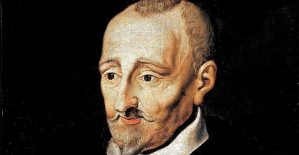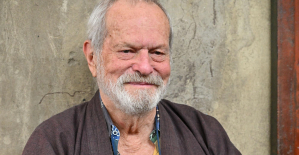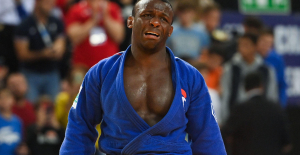When US Commodore Matthew Perry's "Black Ships" entered Edo Bay (now Tokyo) in July 1853, the Japanese Empire had been living under a cheese dome for 250 years. While the world was developing rapidly outside, radical traditionalism prevailed inside. Ever since the shogun (supreme commander) Tokugawa Ieyasu defeated all rivals in 1603 and demoted the emperor to a mere symbol, society had been frozen. Contacts with the outside world were extremely reduced and controlled, wars were forbidden.
This meant that the ancient warrior caste of samurai found themselves deprived of their function. Some were able to maintain their privileged status as vassals or administrators of a daimyo (prince), but many degenerated into farmers, distinguished only by inherited weapons and rank from peasants.
This ended in 1853. Within a few years, the old feudal order collapsed with the shogunate regime. The approximately two million samurai now faced the question of whether they should support the radical modernization of the empire or go into opposition. Saigo Takamori (1828–1877) gave two answers. The first led him to the side of the Meiji Tenno Mutsuhito, who wanted to reform Japan from 1868 as quickly as possible into a western-style great power. The second made him the leader of the great Satsuma uprising that collapsed on September 24, 1877 under fire from the Imperial rapid-fire guns.
Born in 1828 into an impoverished samurai family in the province of Satsuma (now Kagoshima Prefecture) on the southern main island of Kyushu, Saigo was able to maintain his status to some extent as a scribe and gardener in the service of a daimyo. After an exile, during which he also worked philosophically, he rose in 1864 to the military commander of the province.
His old school friend Okubo Toshimichi, who had since risen to provincial governor, had pulled the strings. He was one of the driving forces that formed a broad front against the shogunate and defeated its supporters decisively in 1868. This gave the new Emperor Mutsuhito the opportunity to put his revolutionary modernization project into action. Saigo was first appointed commander of the 100,000-strong Imperial Guard, and in 1872 he was appointed supreme commander of all armed forces in the country.
This made Saigo one of the most influential actors in the so-called Meiji Restoration. With the rank of marshal, he was commissioned to introduce general conscription based on the European model. The training was carried out by German and French officers, and the most modern weapons were purchased abroad. For many samurai, it was a sell-out of their values and their privileges.
Last but not least, this also applied to Saigo. "His strict morality, based on the notions of life and death in traditional philosophy which he had deeply internalized, made him an alien among the men who now ruled the country," writes the samurai specialist Robert Haber setter. Saigo documented his growing distance from the reformers by appearing at the imperial palace in traditional kimono and sandals, while the tenno and his staff wore western tailored suits and uniforms.
However, Saigo's traditionalism was not enough to make him a supporter of the peacetime dictatorship of the defunct shogunate. On the contrary. When the Korean government refused to receive diplomatic embassies from Japan in 1873, he advocated using military force immediately to respond to this disrespect. It was only superficially about restoring national honor. On the contrary, an expedition to the mainland would have given many samurai the opportunity to function in their old role.
The government was realistic enough to reject Saigo's demands. It was said that Japan was not yet sufficiently armed, which was certainly true at the time. When the country finally was, it had no problem getting involved in the imperialist game of the great powers.
Saigo, however, wasn't given that much realism. He took his leave and retired to Satsuma. There he founded a number of private schools in which ancient Japanese values, but above all the warrior ethos of the samurai, were taught. In 1876, when the government forbade samurai from carrying swords and showing their rank by wearing topknots, Saigo's headquarters became the escape for the disenchanted.
With 20,000 men he took up the fight against the "evil advisers" of the Tenno. His old friend Okubo, now promoted to Minister of the Interior, declared Saigo an "enemy of the court for whom there is no place between heaven and earth". With that, Saigo became a symbol of reaction that had to be destroyed.
It was an unequal fight. While government troops had Gatling machine guns and automatic cannons at their disposal, the samurai had to raid depots to obtain their cartridges and cast their bullets from donated metal. Above all, her self-confidence made her overlook the strength of a modern drilled opponent who met his mounted opponents with great discipline of fire.
Thousands of insurgents died from starvation, disease and enemy fire trying to capture an imperial stronghold. Only with difficulty could Saigo lead the survivors to the east of the island. By mid-August, the samurai army had dwindled to 3,000 fighters, their only firearms being historical muskets and wooden cannons wrapped with strips of bamboo. Once again Saigo, with 500 men, escaped from his surrounded position on Mount Enodake, leaving the wounded behind. But he was probably only concerned with finding a worthy place for the last fight.
After refusing the call for surrender, Saigo invited his closest followers to a drink of sake (rice wine), but shortly after midnight enemy artillery ended the party. After heavy shelling, government troops began attacking in the early morning of September 24th. At six o'clock 40 combat-capable samurai were still alive.
Traditionally, Saigo was hit in the groin. Since he could hardly move, he is said to have committed ritual suicide (seppuku) by slitting his stomach with his dagger. However, more recent research has come to the conclusion that his injury no longer allowed this. He was then beheaded by his followers with the sword. His head is said to have been hidden.
The victors hastened to dig him up. Because now the third career of Saigo Takamori began. He was pardoned posthumously and stylized as a symbol of the "noble samurai". Because even modern Japan did not want to do without the warrior ethos of the old days. Unconditional loyalty, ruthless hardness and unconditional willingness to make sacrifices should become the guiding principles of his soldiers.
You can also find "World History" on Facebook. We are happy about a like.

 United States: divided on the question of presidential immunity, the Supreme Court offers respite to Trump
United States: divided on the question of presidential immunity, the Supreme Court offers respite to Trump Maurizio Molinari: “the Scurati affair, a European injury”
Maurizio Molinari: “the Scurati affair, a European injury” Hamas-Israel war: US begins construction of pier in Gaza
Hamas-Israel war: US begins construction of pier in Gaza Israel prepares to attack Rafah
Israel prepares to attack Rafah First three cases of “native” cholera confirmed in Mayotte
First three cases of “native” cholera confirmed in Mayotte Meningitis: compulsory vaccination for babies will be extended in 2025
Meningitis: compulsory vaccination for babies will be extended in 2025 Spain is the country in the European Union with the most overqualified workers for their jobs
Spain is the country in the European Union with the most overqualified workers for their jobs Parvovirus alert, the “fifth disease” of children which has already caused the death of five babies in 2024
Parvovirus alert, the “fifth disease” of children which has already caused the death of five babies in 2024 Falling wings of the Moulin Rouge: who will pay for the repairs?
Falling wings of the Moulin Rouge: who will pay for the repairs? “You don’t sell a company like that”: Roland Lescure “annoyed” by the prospect of a sale of Biogaran
“You don’t sell a company like that”: Roland Lescure “annoyed” by the prospect of a sale of Biogaran Insults, threats of suicide, violence... Attacks by France Travail agents will continue to soar in 2023
Insults, threats of suicide, violence... Attacks by France Travail agents will continue to soar in 2023 TotalEnergies boss plans primary listing in New York
TotalEnergies boss plans primary listing in New York La Pléiade arrives... in Pléiade
La Pléiade arrives... in Pléiade In Japan, an animation studio bets on its creators suffering from autism spectrum disorders
In Japan, an animation studio bets on its creators suffering from autism spectrum disorders Terry Gilliam, hero of the Annecy Festival, with Vice-Versa 2 and Garfield
Terry Gilliam, hero of the Annecy Festival, with Vice-Versa 2 and Garfield François Hollande, Stéphane Bern and Amélie Nothomb, heroes of one evening on the beach of the Cannes Film Festival
François Hollande, Stéphane Bern and Amélie Nothomb, heroes of one evening on the beach of the Cannes Film Festival Skoda Kodiaq 2024: a 'beast' plug-in hybrid SUV
Skoda Kodiaq 2024: a 'beast' plug-in hybrid SUV Tesla launches a new Model Y with 600 km of autonomy at a "more accessible price"
Tesla launches a new Model Y with 600 km of autonomy at a "more accessible price" The 10 best-selling cars in March 2024 in Spain: sales fall due to Easter
The 10 best-selling cars in March 2024 in Spain: sales fall due to Easter A private jet company buys more than 100 flying cars
A private jet company buys more than 100 flying cars This is how housing prices have changed in Spain in the last decade
This is how housing prices have changed in Spain in the last decade The home mortgage firm drops 10% in January and interest soars to 3.46%
The home mortgage firm drops 10% in January and interest soars to 3.46% The jewel of the Rocío de Nagüeles urbanization: a dream villa in Marbella
The jewel of the Rocío de Nagüeles urbanization: a dream villa in Marbella Rental prices grow by 7.3% in February: where does it go up and where does it go down?
Rental prices grow by 7.3% in February: where does it go up and where does it go down? Even on a mission for NATO, the Charles-de-Gaulle remains under French control, Lecornu responds to Mélenchon
Even on a mission for NATO, the Charles-de-Gaulle remains under French control, Lecornu responds to Mélenchon “Deadly Europe”, “economic decline”, immigration… What to remember from Emmanuel Macron’s speech at the Sorbonne
“Deadly Europe”, “economic decline”, immigration… What to remember from Emmanuel Macron’s speech at the Sorbonne Sale of Biogaran: The Republicans write to Emmanuel Macron
Sale of Biogaran: The Republicans write to Emmanuel Macron Europeans: “All those who claim that we don’t need Europe are liars”, criticizes Bayrou
Europeans: “All those who claim that we don’t need Europe are liars”, criticizes Bayrou These French cities that will boycott the World Cup in Qatar
These French cities that will boycott the World Cup in Qatar Medicine, family of athletes, New Zealand…, discovering Manae Feleu, the captain of the Bleues
Medicine, family of athletes, New Zealand…, discovering Manae Feleu, the captain of the Bleues Football: OM wants to extend Leonardo Balerdi
Football: OM wants to extend Leonardo Balerdi Six Nations F: France-England shatters the attendance record for women’s rugby in France
Six Nations F: France-England shatters the attendance record for women’s rugby in France Judo: eliminated in the 2nd round of the European Championships, Alpha Djalo in full doubt
Judo: eliminated in the 2nd round of the European Championships, Alpha Djalo in full doubt


















